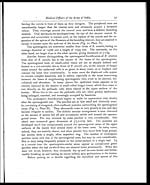Medicine - Institutions > Army health reports and medical documents > Scientific memoirs by medical officers of the Army of India > Part IV, 1889 > 2 - Notes on the life-history of Ravenelia sessilis, B. and Ravenelia stictica, B. and Br.
(38) Page 32
Download files
Individual page:
Thumbnail gallery: Grid view | List view

32
Scientific Memoirs by
fructification, it is necessary to describe certain of the structural features of the
host tissues. The leaves of Pongamia glabra are characterised by the presence
of a double row of pallisade-cells beneath the superior epidermis. Beneath the
deep row of pallisade-cells is a stratum characterised by the presence of large,
irregularly rounded cells, between which and the inferior epidermis one or two
rows of delicate elongated cells, with their long axis vertical to the epidermis,
and leaving large intercellular spaces, build up a loose tissue.
Dense masses of delicate jointed mycelial filaments are visible at the level
of the deeper pallisade-cells and of the stratum of large rounded cells imme-
diately beneath them, and these, in the case of the majority of pustules—of all
those appearing on the inferior surfaces of the leaves—are continuous with solid
masses of small-celled tissue which surround and displace the deeper portions of
the subepidermal tissue to form the sporogenic bases of the pustules. The stalks
of the uredospores thus originate relatively far from the surface and pass up
between the superficial portions of the subepidermal tissue, while the spores
themselves are developed beneath the epidermis, which they gradually elevate,
and ultimately rupture, as they increase in size and number. Due to the deep
origin of the stalks the spores might readily be supposed to be sessile, as, when
detached naturally or by means of friction, they, of course, very seldom carry
any portion of their stalks along with them, and it is only in sections in which
they remain in their normal position that their true character becomes visible.
Where uredosporic pustules appear on the upper sufaces of the leaves the spores
are developed subepidermally also, but the sporagenic beds of small-celled tissue
do not lie so deeply as in the previous case, being apparently developed between
the under surface of the epidermis and the outer extremities of the pallisade-
cells.
The young uredospores are oval, but, as they mature, they become broader,
and many of them are ultimately almost spherical (Fig. 7, Plate II). Two
of average size were measured while dry, and gave diameters of.0195 x.0195
and.021 x.0195 mm. A slight increase in size usually occurs when they are
immersed in water. They are yellowish brown, and the epispore is everywhere
thickly tuberculate, save at one large rounded area, apparently corresponding
with the site of insertion of the stalk. Just as in the case of R. sessilis there is
no evidence of general diffusion of infection over the surfaces of the leaves at this
period, the groups of pustules being limited to the immediate neighbourhood of
the spermogonial areas which they surround, and towards the close of the hot
weather the fructification is almost, if not entirely over, the sites of previous sper-
mogonio-uredal patches being merely indicated by brown desiccated spots, or by
perforations in the laminæ resulting from their disintegration.
Only a very limited fall of old leaves and evolution of new ones accompanies
the onset of the rains in Pongamia glabra, and for some time the parasite makes
no sign of its presence. Generally diffused infection of the deeper tissues must,
Set display mode to: Large image | Zoom image | Transcription
Images and transcriptions on this page, including medium image downloads, may be used under the Creative Commons Attribution 4.0 International Licence unless otherwise stated. ![]()
| Permanent URL | https://digital.nls.uk/74999994 |
|---|
| Shelfmark | IP/QB.10 |
|---|---|
| Additional NLS resources: | |




